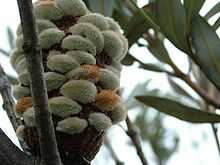Banksia saxicola
| Banksia saxicola | |
|---|---|
 | |
| Scientific classification | |
| Kingdom: | Plantae |
| (unranked): | Angiosperms |
| (unranked): | Eudicots |
| Order: | Proteales |
| Family: | Proteaceae |
| Genus: | Banksia |
| Species: | B. saxicola |
| Binomial name | |
| Banksia saxicola A.S.George | |
Banksia saxicola, commonly known as the rock banksia or Grampians banksia, is a species of tree or shrub in the plant genus Banksia. It occurs in Victoria in two distinct populations, one in The Grampians and the other on Wilsons Promontory. It has leathery green leaves and grey-yellow flower spikes which appear in summer and early autumn.
Description
Banksia saxicola grows as a tall upright tree to 13 metres (43 ft) high at Wilsons Promontory, or as a sprawling shrub in the Grampians.[1] At the latter location, plants maintain their spreading habit even in more sheltered parts, reaching around 5 metres (20 ft) high there but restricted to 2 metres (7 ft) high in more exposed areas.[2] The leathery dark green leaves are roughly oval and measure 4 to 10 centimetres (2 to 4 in) long by 1 to 3.5 centimetres (0.39 to 1.4 in) wide. They are arranged in whorls along the stems. The flowering period is from January to March, the cylindrical flower spikes, known as inflorescences, arising from two- to six-year old branches. They are 3.5 to 8 centimetres (1.4 to 3.1 in) high and 5 to 6 centimetres (2 to 2 in) wide at anthesis. Flower parts fall off the ageing spikes, leaving them bare. They swell and develop 20 to 60 follicles that are covered in fine fur and open only when burnt in fire.[1]
Taxonomy
Long held to be a form of Banksia integrifolia, Banksia saxicola was formally described by Alex George in his 1981 monograph of the genus Banksia.[1] The species name is derived from the Latin words saxum "rock" and verb cŏlo "inhabit" or "grow in".[3] The type specimen was collected from the summit of Mount William in the Grampians on 17 February 1977.[1]
George concluded it was most closely related to Banksia canei.[1]
Distribution and habitat
In The Grampians, Banksia saxicola grows on exposed summits and slopes as well as gullies in scrub or woodland on a loamy soil, generally among sandstone boulders, with such species as Eucalyptus baxteri. It is found at altitudes above 600 m (2000 ft). It is found in taller forest at altitudes of 200 to 300 metres (700 to 1,000 ft) at Wilsons Promontory.[1]
Ecology
Banksia saxicola plants are killed by bushfire and regenerate from seed.[1]
Birds observed visiting flower spikes include the New Holland Honeyeater and Crescent Honeyeater.[2]
Cultivation
Banksia saxicola adapts readily to cultivation, particularly in cooler climates, and has been grown outside in the United Kingdom, Tasmania and at Lees in the Netherlands.[4] Its attractive foliage and furry follicles (which can look as if snowed on) are its horticultural features. It flowers in 3 to 4 years from seed.[4]
References
- ↑ 1.0 1.1 1.2 1.3 1.4 1.5 1.6 George, Alex S. (1981). "The Genus Banksia L.f. (Proteaceae)". Nuytsia 3 (3): 239–473 [297–300]. ISSN 0085-4417.
- ↑ 2.0 2.1 Taylor, Anne; hopper, Stephen (1988). The Banksia Atlas (Australian Flora and Fauna Series Number 8). Canberra, Australian Capital Territory: Australian Government Publishing Service. pp. 204–05. ISBN 0-644-07124-9.
- ↑ Simpson, D. P. (1979) [1854]. Cassell's Latin Dictionary (5 ed.). London: Cassell Ltd. pp. 116, 536. ISBN 0-304-52257-0.
- ↑ 4.0 4.1 Collins, Kevin; Collins, Kathy; George, Alex S. (2008). Banksias. Melbourne, Victoria: Bloomings Books. pp. 319–20. ISBN 1-876473-68-1.
| Wikispecies has information related to: Banksia saxicola |
- George, Alex (1999). "Banksia". In Wilson, Annette. Flora of Australia: Volume 17B: Proteaceae 3: Hakea to Dryandra. CSIRO Publishing / Australian Biological Resources Study. pp. 175–251. ISBN 0-643-06454-0.
External links
- "Banksia saxicola". Flora of Australia Online. Department of the Environment and Heritage, Australian Government.